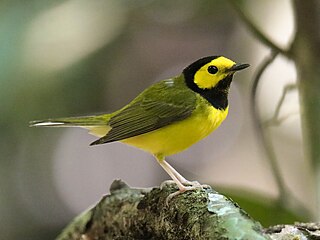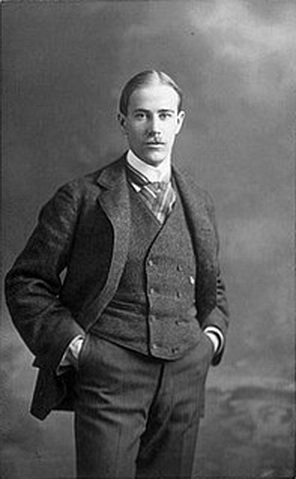Related Research Articles

Taxidermy is the art of preserving an animal's body by mounting or stuffing, for the purpose of display or study. Animals are often, but not always, portrayed in a lifelike state. The word taxidermy describes the process of preserving the animal, but the word is also used to describe the end product, which are called taxidermy mounts or referred to simply as "taxidermy".

The hooded warbler is a New World warbler. It breeds in eastern North America across the eastern United States and into southernmost Canada (Ontario). It is migratory, wintering in Central America and the West Indies. Hooded warblers are very rare vagrants to western Europe.

The Canada warbler is a small boreal songbird of the New World warbler family (Parulidae). It summers in Canada and northeastern United States and winters in northern South America.

Louis Agassiz Fuertes was an American ornithologist, illustrator and artist who set the rigorous and current-day standards for ornithological art and naturalist depiction and is considered one of the most prolific American bird artists, second only to his guiding professional predecessor John James Audubon.

Townsend's warbler is a small songbird of the New World warbler family.

Clinton Hart Merriam was an American zoologist, mammalogist, ornithologist, entomologist, ecologist, ethnographer, geographer, naturalist and physician. He was commonly known as the "father of mammalogy," a branch of zoology referring to the study of mammals.
Constantine Walter Benson OBE was a British ornithologist and author of over 350 publications. He is considered the last of a line of British Colonial officials that made significant contributions to ornithology.
George Bristow was an English taxidermist and gunsmith of St Leonards-on-Sea in the borough of Hastings, East Sussex, in the southeast of England.

The Hastings Rarities affair is a case of statistically demonstrated ornithological fraud that misled the bird world for decades in the 20th century. The discovery of the long-running hoax shocked ornithologists.

William Edwin Brooks was a civil engineer in India and an ornithologist. He later settled in Canada where his son Allan Cyril Brooks also became an ornithologist and bird artist of repute. Brooks was a pioneer of identifying species by their calls and he described several new species, particularly warblers in collaboration with Allan Octavian Hume. Brooks's leaf warbler is named after him.

Charles Johnson Maynard was an American naturalist and ornithologist born in Newton, Massachusetts. He was a collector, a taxidermist, and an expert on the vocal organs of birds. In addition to birds, he also studied mollusks, moss, gravestones and insects. He lived in the house at 459 Crafts Street in Newton, Massachusetts, built in 1897 and included in the National Register of Historic Places in 1996 as the Charles Maynard House. The Charles Johnson Maynard Award is given out by the Newton Conservators, Inc.
Charles-Eusèbe Dionne, also known as Charles Eusebe or C. E. Dionne, was a French Canadian naturalist and taxidermist. He is considered the first professional French Canadian ornithologist. Dionne was a self-taught scientist and wrote several books on the natural history of Quebec, including the first field guide to the province's mammal fauna; he was a well-respected scholar and became a fellow of the American Ornithologists' Union.

John Hancock was an English naturalist, ornithologist, taxidermist and landscape architect. Working during the golden age of taxidermy when mounted animals became a popular part of Victorian era interior design, Hancock is considered the father of modern taxidermy

Martha Ann Maxwell was an American naturalist, artist and taxidermist. She helped found modern taxidermy. Maxwell's pioneering diorama displays are said to have influenced major figures in taxidermy history who entered the field later, such as William Temple Hornaday and Carl Akeley. She was born in Pennsylvania in 1831. Among her many accomplishments, she is credited with being the first woman field naturalist to obtain and prepare her own specimens. She was inducted into the Colorado Women's Hall of Fame in 1985.

Taxidermy, or the process of preserving animal skin together with its feathers, fur, or scales, is an art whose existence has been short compared to forms such as painting, sculpture, and music. The word derives from two Greek words: taxis, meaning order, preparation, and arrangement and derma, meaning skin. Directly translated, taxidermy means "skin art."
Greene Smith (1842–1886) was an American amateur scientist and taxidermist with a specific interest in ornithology. His father was Gerrit Smith.

Frank Blake Webster was an influential ornithological publisher, taxidermist and natural history dealer in the late 19th century.
Allan Leopold Moses was a Canadian naturalist, taxidermist, and conservationist. A native of Grand Manan Island in the Bay of Fundy, he participated in scientific expeditions sponsored by the Cleveland Museum of Natural History and the American Museum of Natural History. By encouraging John Sterling Rockefeller to purchase Kent Island as a bird sanctuary in 1930, he was instrumental in the revival of the Bay of Fundy common eider population. His taxidermy collection of over 300 birds, all mounted by his grandfather, father, or himself and now displayed in the Grand Manan Museum, is one of the largest in Canada.

Herbert L. Stoddard was an American naturalist, conservationist, forester, wildlife biologist, ecologist, ornithologist, taxidermist, and author. In the 20th century he earned a reputation for being one of the American Southeast's most prominent conservationists and a pioneering forest ecologist. He is most well known for his seminal book, The Bobwhite Quail: Its habits, preservation, and increase (1931). He is also widely credited with advocating for the practice of prescribed fire as a tool for wildlife management. He was married to Ada Wechselberg, with whom he had one son, Herbert "Sonny" L. Stoddard Jr.
Harold Ford Mayfield was an American business executive and amateur ornithologist who made a major study of Kirtland's warbler and worked for the preservation of their breeding areas. During his study of the warbler, he introduced a standardized measure of nesting success based on his professional experience in industry and from his training in mathematics. This method now widely known as the Mayfield Method involves probability calculations that take into account nests that the observer was unable to locate. Prior to his work, ornithologists used naïve approaches based on fractions of number of successful young or nests from a total of nests that they had found.
References
- ↑ "Photos of Cyrus Black - Find a Grave Memorial". www.findagrave.com.
- 1 2 3 4 5 6 7 Sharpe, Roger S.; Silcock, W. Ross; Jorgensen, Joel G. (2001). Birds of Nebraska. Lincoln, Nebraska: University of Nebraska Press. ISBN 0-8032-4289-1.
- 1 2 "Cy Black minor league baseball Statistics on StatsCrew.com". www.statscrew.com.
- 1 2 3 4 5 6 7 8 9 10 11 12 Poell, Charles (November 16, 1957). "'Cy' Black's Duck and Goose Decoys Are Prized by Sportsmen In all Parts of Country". Kearney Hub.
- ↑ "Want Ads". Kearney Daily Hub. October 16, 1917.
- ↑ "Fine Specimen of Eagle". Kearney Hub. February 23, 1915.
- ↑ "Name examiners for scout tests: Vocational training is part of boys' activities". Kearney Hub. May 9, 1929.
- ↑ Nebraska Ornithologists' Union (1933). "Annual meetings of the Nebraska Ornithologists' Union". Nebraska Bird Review. 1 (1): 24.
- 1 2 Black, C. A. (1922). "Some Bird Notes from Central and Western Nebraska". The Wilson Bulletin. 34 (1): 43–43. ISSN 0043-5643.
- 1 2 Swenk, Myron H. (1918). "Revisory Notes on the List of the Birds of Nebraska". The Wilson Bulletin. 30 (4): 112–117. ISSN 0043-5643.
- 1 2 3 "Rare Bird Located Here: Swanson Warbler Is Captured By C. A. Black". Kearney Hub. May 2, 1936.